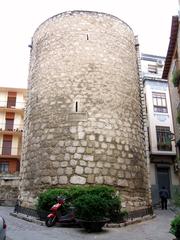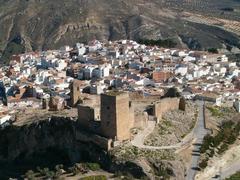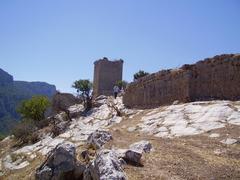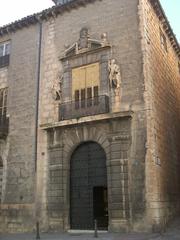Visiting Hours, Tickets, and Historical Insights: Catedral de la Asunción de Jaén, Jaén, Spain
Date: 18/07/2024
Introduction
The Catedral de la Asunción de Jaén, often referred to as Jaén Cathedral, stands as an architectural and cultural gem in the heart of Jaén, Spain. This monumental structure is a testament to the rich historical tapestry that defines the region. Originally built on the site of a former mosque following the Reconquista in the 13th century, the cathedral has evolved through centuries to become a harmonious blend of Gothic, Renaissance, and Baroque styles (Spain.info). The cathedral’s design, spearheaded by renowned architect Andrés de Vandelvira in the 16th century, features elements of Spanish Renaissance architecture, characterized by its symmetry, proportion, and classical orders (Andalucia.org).
Beyond its architectural splendor, the Catedral de la Asunción de Jaén holds immense historical and religious significance. It is home to the Holy Face of Jaén (El Santo Rostro), a revered relic believed to bear the image of Christ’s face, which attracts pilgrims and visitors alike (Holy Face of Jaén). The cathedral’s role during the Spanish Civil War, where it served as a refuge and storage for valuable artworks, underscores its historical resilience (Spanish Civil War).
Today, efforts to preserve and restore the cathedral continue, with ongoing projects aimed at maintaining its structural integrity and historical significance. These initiatives are bolstered by its status as a Cultural Heritage Site and its inclusion in the UNESCO World Heritage list as part of the Renaissance Monumental Ensembles of Úbeda and Baeza (UNESCO). This guide provides a comprehensive overview of the Catedral de la Asunción de Jaén, offering visitors essential information on its history, architectural significance, visiting details, and travel tips to enhance their experience.
History of the Catedral de la Asunción de Jaén
Early Beginnings and Construction
The origins of the Catedral de la Asunción de Jaén date back to the 13th century, following the Reconquista, when King Ferdinand III of Castile recaptured Jaén from the Moors in 1246. The initial structure was built on the site of a former mosque, a common practice during the Reconquista to symbolize the triumph of Christianity over Islam (Spain.info).
Renaissance Influence
The current structure of the cathedral began to take shape in the 16th century. The design was spearheaded by Andrés de Vandelvira, a prominent architect of the Spanish Renaissance. Vandelvira’s work on the cathedral, which began in 1548, is considered one of his masterpieces. His design incorporated elements of the Renaissance style, characterized by symmetry, proportion, and the use of classical orders (Andalucia.org).
Architectural Evolution
The construction of the cathedral spanned several centuries, with significant contributions from various architects. After Vandelvira’s death in 1575, the project was continued by his disciples, including Alonso Barba and Eufrasio López de Rojas. The cathedral was finally consecrated in 1724, although construction continued intermittently until the 18th century. This prolonged construction period resulted in a blend of architectural styles, with Renaissance elements being predominant but also incorporating Baroque influences (Catedraldejaen.org).
The Holy Face of Jaén
One of the most significant historical aspects of the cathedral is its association with the Holy Face of Jaén (El Santo Rostro), a revered relic believed to be a cloth that bears the image of Christ’s face. According to tradition, the relic was brought to Jaén by King Ferdinand III after the Reconquista. The Holy Face is housed in a special chapel within the cathedral and is a focal point of religious devotion, particularly during the annual Holy Week processions (Holy Face of Jaén).
Role in the Spanish Civil War
The cathedral also played a notable role during the Spanish Civil War (1936-1939). It served as a refuge for civilians and a storage place for valuable artworks and religious artifacts. Despite the turmoil of the war, the cathedral sustained minimal damage, allowing it to preserve its historical and architectural integrity (Spanish Civil War).
Restoration and Preservation
In the 20th and 21st centuries, the cathedral has undergone several restoration projects to preserve its structural integrity and historical significance. These efforts have included the restoration of the façade, the reinforcement of the foundations, and the conservation of the interior artworks and relics. The cathedral was declared a Cultural Heritage Site (Bien de Interés Cultural) in 1931, underscoring its importance as a historical and cultural monument (Cultural Heritage Site).
UNESCO World Heritage Status
In 2012, the Catedral de la Asunción de Jaén was included in the UNESCO World Heritage list as part of the Renaissance Monumental Ensembles of Úbeda and Baeza. This recognition underscores the cathedral’s global significance as an outstanding example of Renaissance architecture and its contribution to humanity’s cultural heritage. The UNESCO status has also helped in the preservation and promotion of the cathedral, attracting scholars and tourists from around the world (UNESCO).
Visitor Information
Visiting Hours and Tickets
The Catedral de la Asunción de Jaén is open to visitors throughout the year. Typical visiting hours are from 10:00 AM to 2:00 PM and 4:00 PM to 7:00 PM, but it’s recommended to check the official website for any changes or special closures. Ticket prices vary, with discounts available for students, seniors, and groups. For the most current information on ticket prices and visiting hours, visit the cathedral’s official website.
Guided Tours and Special Events
Guided tours are available and highly recommended for those who wish to delve deeper into the cathedral’s history and architecture. These tours often include access to areas not available to the general public. The cathedral also hosts a variety of special events throughout the year, including concerts, religious ceremonies, and cultural events (Jaén Cathedral Events).
Travel Tips and Nearby Attractions
Accessibility
The cathedral is accessible to visitors with disabilities, with ramps and elevators available for ease of access. There are also facilities such as restrooms and seating areas to ensure a comfortable visit.
Nearby Attractions
While visiting the Catedral de la Asunción de Jaén, take the opportunity to explore other nearby attractions. The Arab Baths, the Castle of Santa Catalina, and the Museum of Jaén are all within a short distance and offer additional insights into the rich history and culture of the region.
Conclusion
The history of the Catedral de la Asunción de Jaén is a rich tapestry woven with threads of architectural innovation, religious devotion, and cultural significance. From its origins in the aftermath of the Reconquista to its ongoing role as a center of religious and cultural life, the cathedral stands as a testament to the enduring legacy of Jaén’s historical and architectural heritage. Plan your visit today and immerse yourself in the beauty and history of this remarkable monument.
FAQ
What are the visiting hours for Catedral de la Asunción de Jaén? The typical visiting hours are from 10:00 AM to 2:00 PM and 4:00 PM to 7:00 PM. Check the official website for the most current information.
How much are the tickets for Jaén Cathedral? Ticket prices vary, with discounts available for students, seniors, and groups. Visit the cathedral’s official website for the latest prices.
Are guided tours available? Yes, guided tours are available and recommended for a deeper understanding of the cathedral’s history and architecture.
Is the cathedral accessible for visitors with disabilities? Yes, the cathedral is accessible, with ramps and elevators available.
Call to Action
For more information on visiting the Catedral de la Asunción de Jaén, download our mobile app Audiala, explore related articles on our site, and follow us on social media for the latest updates and travel tips.
Conclusion
The Catedral de la Asunción de Jaén is more than just a religious monument; it is a symbol of Jaén’s rich cultural, historical, and architectural heritage. From its origins in the aftermath of the Reconquista to its ongoing preservation efforts, the cathedral stands as a testament to the region’s historical resilience and artistic legacy. Its architectural evolution, from Gothic to Renaissance and Baroque styles, reflects the changing dynamics of Spanish architecture over the centuries (Spain.info).
The cathedral’s significance extends beyond its architectural beauty. It holds a central place in the religious and cultural life of Jaén, housing revered relics like the Holy Face of Jaén and serving as a focal point for religious and community events (Holy Face of Jaén). The ongoing restoration projects underscore the importance of preserving this historical monument for future generations, supported by its recognition as a UNESCO World Heritage Site (UNESCO).
Visitors to the Catedral de la Asunción de Jaén can immerse themselves in its rich history and architectural splendor, guided by comprehensive tours and supported by modern accessibility features. The cathedral’s role in the local economy, educational value, and community engagement further highlight its multifaceted significance. As you plan your visit, take the opportunity to explore the nearby attractions and savor the local culture, ensuring a memorable and enriching experience in Jaén. For more information and updates, download the Audiala mobile app and follow us on social media.
References
- Visiting the Catedral de la Asunción de Jaén, 2024, Spain.info https://www.spain.info/en/places-of-interest/jaen-cathedral/
- Visiting the Catedral de la Asunción de Jaén, 2024, Andalucia.org https://www.andalucia.org/en/jaen-cultural-tourism-cathedral
- The Holy Face of Jaén, 2024, Catedraldejaen.org https://www.catedraldejaen.org/el-santo-rostro/
- Spanish Civil War, 2024, Britannica.com https://www.britannica.com/event/Spanish-Civil-War
- Renaissance Monumental Ensembles of Úbeda and Baeza, 2024, UNESCO https://whc.unesco.org/en/list/522



